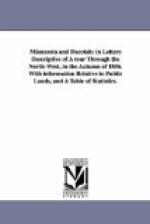“Same smooth prairie as above to Bois des Sioux River, sometimes soft and miry; camp on river bank; wood and grass good— river water fair; many catfish caught in the river.
“June 29. Cross Bois des Sioux River; seventy feet wide, four to seven feet deep; muddy bottom; steep and miry banks; goods boated over; wagons hauled through, light, with ropes; bad crossing, but passable; smooth flat prairie, as on the east side of Bois des Sioux, occasionally interrupted with open sloughs to Wild Rice River, and camp with wood, water, and abundant grass.
“June 30. Wild Rice River, about forty feet wide and five and a half feet deep, with muddy and miry bottom and sides, flowing in a canal-like channel, some twenty feet below prairie level; river skirted with elm— bridged from the steep banks, being too miry to sustain the animals, detaining the train but little more than half-a-day; small brook without wood, flowing in a broad channel cut out through the prairie; crossing miry, but made passable for the wagon by strewing the bottom with mown grass.
“Firm prairie to camp on edge of above small stream; good grass and water; no wood; elk killed by hunter.
“July 1. Smooth prairie extending to Shayenne River; sand knolls, ponds, and marshes frequent as the river is approached. The marshes were not miry— firmer bottom; good wagon road; night encampment on bank of river; sufficient grass for train; wood abundant; river water good; many catfish caught in river.
“July 2. Shayenne River, sixty feet wide, fourteen feet deep; river had been previously bridged by Red River train, from the poplars and other trees growing on the river, and this bridge we made use of in crossing our wagons; camp on the west bank of the river; water, wood, and grass good.
“July 4. Prairie undulation, interrupted with marshes, small ponds and occasional small rivulets, to Maple River, about twenty-five feet wide, three and a half feet deep, firm bottom, and easily passed by the wagons; river tolerably well wooded, and the camp on its edge is furnished with water, wood, and good grass. The rich black soil of the valley of this stream is noticeable.
“July 5. To a small stream thirty feet wide, two feet deep, clayey bottom, easily crossed by the wagons; prairie high, firm, and almost level for some thirteen miles, becoming more rolling and with small ponds in the last seven miles of the march; on the edge of some of the ponds are salt incrustations; camp on the river; water good; grass good; no wood, and the bois de vache is used for fuel.
“July 6. Country wet and marshy; not a tree in sight; prairie with low ridges and knolls, and great number of ponds and marshes; night’s camp by a small pond; no wood, but plenty of bois de vache; grass good.
“July 7. Approaching the Shayenne; country as yesterday for some half dozen miles; bordering on the river the ground is broken with deep coulees and ravines, and to keep away from them the train kept at some distance from the river, encamping by a small marshy pond; no wood; plenty of bois de vache; grass good; water tolerable; first buffalo killed to-day.




